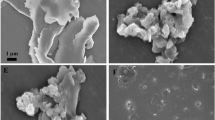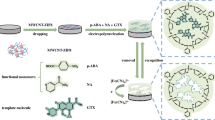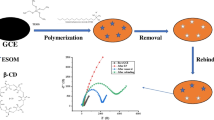Abstract
The key to develo** sensors for chiral drug determination is to exclude interference from enantiomers. In this study, metal–organic frameworks (MOFs) and molecularly imprinted polymer (MIP) were introduced to prepare a chiral sensor for levofloxacin detection. The MIP was electropolymerised on the surface of the Cu/Fe-benzene-1,3,5-tricarboxylate MOF (Cu/Fe-BTC)-modified Au electrode using levofloxacin as a template molecule. After eluting the levofloxacin, a chiral sensor with recognition sites for levofloxacin was obtained. With this site as a switch, a novel method for detecting levofloxacin was established. Because of the enhanced recognition effect, the sensor can effectively exclude the enantiomeric interference of d-ofloxacin. Moreover, Cu/Fe-BTC can effectively amplify the current response signal and improve the sensitivity of the sensor. The linear range of the sensor was 5 to 4000 × 10−11 mol L−1, and the detection limit was 2.07 × 10−11 mol L−1. When applied to detecting levofloxacin in actual samples, the sensor showed a 92.7–109.8% recovery.
Graphical Abstract







Similar content being viewed by others
References
Asnin L, Kopchenova M, Vozisov S, Klochkova M, Klimova Y (2020) Enantioselective retention mechanisms of dipeptides on antibiotic-based chiral stationary phases. II. effect of the methanol content in the mobile phase. J Chromatogr A 1626:461371
Rosi-Marshall E, Snow D, Bartelt-Hunt S, Paspalof A, Tank J (2015) A review of ecological effects and environmental fate of illicit drugs in aquatic ecosystems. J Hazard Mater 282:18–25
Gauquier P, Vanommeslaeghe K, Heyden Y, Mangelings D (2022) Modelling approaches for chiral chromatography on polysaccharide-based and macrocyclic antibiotic chiral selectors: a review. Anal Chim Acta 1198:338861
Ghanem A, Marzouk A, Sobhy M, Fouad A (2022) A polymer-based monolithic capillary column with polymyxin-B chiral selector for the enantioselective nano-high performance liquid chromatographic pharmaceutical analysis. J Chromatogr A 1662:462714
Chen L, Xu S, Li J (2011) Recent advances in molecular imprinting technology: current status, challenges and highlighted applications. Che Soc Rev 40:2922–2942
Dashtian K, Hajati S, Ghaedi M (2022) Molecular imprinted poly(2,5-benzimidazole)- modified VO2-CuWO4 homotype heterojunction for photoelectrochemical dopamine sensing. Anal Chem 94:6781–6790
BelBruno J (2018) Molecularly imprinted polymers. Chem Rev 119:94–119
Li T, Deng Z, Bu J, Liu H, Yang Y, Zhong S (2022) Quantum dot based molecularly imprinted polymer test strips for fluorescence detection of ferritin. Sensor Actuat B-Chem 358:131548
Zhang L, Luo K, Li D, Zhang Y, Li J (2020) Chiral molecular imprinted sensor for highly selective determination of D-carnitine in enantiomers via dsDNA-assisted conformation immobilization. Anal Chim Acta 1136:82–90
Li S, Pang C, Ma X, Zhao M, Li H, Wang M, Li J, Luo J (2020) Chiral drug fluorometry based on a calix[6]arene/molecularly imprinted polymer double recognition element grafted on nano-C-dots/Ir/Au. Microchim Acta 187:394
Kitagawa S (2014) Metal-organic frameworks (MOFs). Chem Soc Rev 43:5415–5418
Yu L, Zheng Q, **ong L, Feng L, **ao Y (2022) Dual-lanthanide urea metal-organic framework based fluorescent traffic light microsensor for solvent decoding and visual trace water assay. Sensor Actuat B-Chem 356:131328
Gu Y, Zheng J, Otake K, Sugimoto K, Hosono N, Sakaki S, Li F, Kitagawa S (2020) Structural-deformation-energy-modulation strategy in a soft porous coordination polymer with an interpenetrated framework. Angew Chem Int Edit 59:15517–15521
Feng T, Wang Y, Wu Y, Kabtamu D, LászlóK LF (2020) A feasible linker transformation strategy towards the formation of Cu2O nanoparticles for immobilization in hierarchical cubtc for adsorption desulfurization. J Mat Chem A 8:8678–8683
Wu Q, Tan R, Mi X, Tu Y (2020) Electrochemiluminescent aptamer-sensor for alpha synuclein oligomer based on a metal-organic framework. Analyst 145:2159–2167
Orman M, Ozcelikay G, Cetinkaya A, Kaya S, Armutcu C, Zgür E, Uzun L, Ozkan A (2022) Metal-organic frameworks as an alternative smart sensing platform for designing molecularly imprinted electrochemical sensors. TrAC-Trend Anal Chem 150:116573
Wang F, Zhu L, Zhang J (2014) Electrochemical sensor for levofloxacin based on molecularly imprinted polypyrrole-graphene-gold nanoparticles modified electrode. Sensor Actuat B-Chem 192:642–647
Azab N, Mahmoud A, Trabik Y (2022) Point-of-care diagnostics for therapeutic monitoring of levofloxacin in human plasma utilizing electrochemical sensor mussel-inspired molecularly imprinted copolymer. J Electroanal Chem 918:116504
Nguyen L, Nguyen K (2012) Metal-organic framework MOF-199 as an efficient heterogeneous catalyst for the aza-Michael reaction. Appl Catal A-Gen 425–426:44–52
Israr F, Kim D, Kim Y, Yeongmin K, Oh S (2015) Cost effective and low energy consuming hydrothermal synthesis of Ni based MOF. Energy Eng 24:51–54
Cruz-Navarro J, Mendoza-Huizar L, Salazar-Pereda V, Romo-Gómez C, Cobos-Murcia J, Álvarez-Romero G (2022) A Cu (II)-BTC metal-organic framework modified carbon paste electrode and its application as electrochemical sensor for methanol determination. J Electrochem Soc 169:037509
Jahan M, Liu Z, Loh K (2013) A graphene oxide and copper-centered metal organic framework composite as a tri-functional catalyst for HER, OER, and ORR. Adv Funct Mater 23:5363–5372
Wu X, Lu W (2018) High-performance electrochemical glucose sensing enabled by Cu(TCNQ) nanorod array. Nanotechnology 29:135502
Luo J, Li S, Wu Y, Pang C, Ma X, Wang M, Zhang C, Xu Z, Li B (2022) Electrochemical sensor for imidacloprid detection based on graphene oxide/gold nano/β-cyclodextrin multiple amplification strategy. Microchem J 183:107979
Zhao S, Wang Y, Dong J, He C, Yin H, An P, Zhao K, Zhang X, Gao C, Zhang L, Lv J, Wang J, Zhang J, Khattak A, Khan N, Wei Z, Zhang J, Liu S, Zhao H, Tang Z (2016) Ultrathin metal-organic framework nanosheets for electrocatalytic oxygen evolution. Nat Energy 1:16184
Kaur R, Rana S, Lalit K, Singh P, Kaur K (2020) Electrochemical detection of methyl parathion via a novel biosensor tailored on highly biocompatible electrochemically reduced graphene oxide-chitosan-haemoglobin coatings. Biosens Bioelectron 167:112486
Chen Z, Zhang Y, Yang Y, Shi X, Jia G (2021) Hierarchical nitrogen-doped holey graphene as sensitive electrochemical sensor for methyl parathion detection. Sensor Actuat B-Chem 336:129721
Funding
This study was supported by the Chinese Academy of Tropical Agricultural Sciences for Science and Technology Innovation Team of National Tropical Agricultural Science Center (CATASCXTD202314); the CARS (CARS-31); the Key Laboratory of Tropical Fruits and Vegetables Quality and Safety for State Market Regulation (ZX-2023002); and the Hainan Province Science and Technology Special Fund (ZDYF2022XDNY232).
Author information
Authors and Affiliations
Corresponding authors
Ethics declarations
Competing interests
The authors declare no competing interests.
Additional information
Publisher's Note
Springer Nature remains neutral with regard to jurisdictional claims in published maps and institutional affiliations.
Supplementary Information
Below is the link to the electronic supplementary material.
Rights and permissions
Springer Nature or its licensor (e.g. a society or other partner) holds exclusive rights to this article under a publishing agreement with the author(s) or other rightsholder(s); author self-archiving of the accepted manuscript version of this article is solely governed by the terms of such publishing agreement and applicable law.
About this article
Cite this article
Deng, Y., Li, S., Ma, X. et al. Electrochemical chiral sensor for levofloxacin detection base on Cu/Fe-BTC amplification. Microchim Acta 190, 435 (2023). https://doi.org/10.1007/s00604-023-06009-1
Received:
Accepted:
Published:
DOI: https://doi.org/10.1007/s00604-023-06009-1




